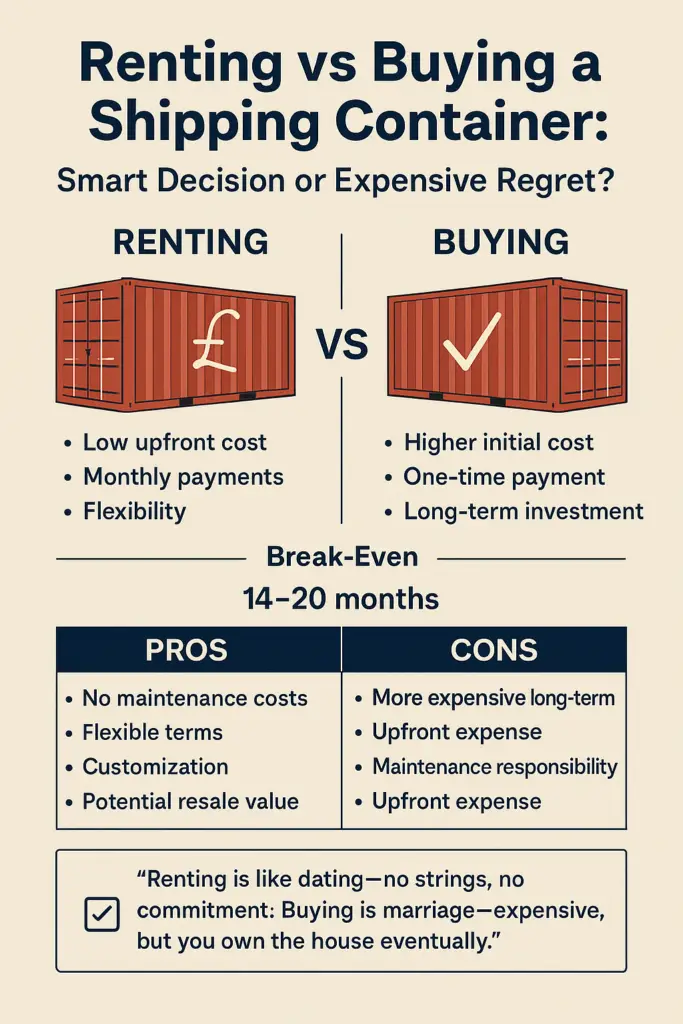Ever wondered whether you’d be better off renting a shipping container like a short-term fling, or investing in one as a long-term partner?
Shipping container rental or buying: The decision to rent or buy a shipping container isn’t as simple as choosing between instant noodles and a three-course meal. One is quick and convenient, the other is more of a commitment. Both serve a purpose—but only one will keep you satisfied in the long run.
In today’s market, renting a container will typically (please use costs mentioned as a guide) set you back around £130–£180 per month for a standard 20ft, with additional delivery and collection fees of £150–£350 each way. Buying, however, requires a one-off outlay of £1,500–£3,000 for the same size. The maths suggests that if you plan on using it for longer than 14–20 months, you’re better off buying.
But this isn’t just about numbers. Renting offers flexibility and zero maintenance worries, while ownership gives you freedom to customise and resale value. The choice depends on whether you need a temporary solution, a permanent fixture, or something you can transform into the world’s quirkiest garden office.
Let’s dive into the details—without sugar-coating the hidden costs or market quirks.
- If you’d like a firm, written quote tailored to your postcode, access, spec and timeline, shout and we’ll run the numbers properly—no surprises, no steel-flavoured heartburn.
The Price Puzzle: Upfront vs Ongoing
Renting:
- Perfect for businesses and individuals who need storage or workspace short-term.
- Pay monthly, usually between £130–£180, and walk away when you’re finished.
- The provider often takes care of maintenance, so no need to worry about rusty doors or warped flooring.
Buying:
- Big upfront cost of £1,500–£3,000, but no monthly drain.
- It’s yours to use, abuse, paint pink, or convert into a yoga studio.
- Resale potential—containers don’t lose value overnight, especially in times of global shortage.
Break-Even Point:
- Typically falls around 14–20 months of use. Beyond that, you’re just lining the pockets of the rental company.
Flexibility vs Ownership
Renting is like borrowing your mate’s car. You can drive it around, but don’t dare scratch it or stick a spoiler on the back. You’re bound by the terms: no structural changes, no hazardous materials, and you’d better return it in good nick.
Buying is ownership. You can modify it—cut in windows, add electrics, weld on shelving—without asking permission. For businesses that need reliable long-term storage or plan to build a permanent conversion, ownership is the only sensible choice.

Hidden Costs to Watch
With Renting:
- Delivery and collection fees add up fast. A couple of hundred quid each way is common.
- Cleaning or damage fees if you return it in worse condition than when it arrived.
- Rental contracts can be rigid, penalising you for early termination or over-use.
With Buying:
- You’re responsible for all maintenance. Containers are tough, but they do rust, particularly in damp UK weather.
- Insulating, painting, or modifying adds further expense.
- Storage of the container itself can be tricky if you don’t have space.
The Market in 2025
The container market has been anything but boring. Global supply chain hiccups, steel prices, and the ongoing boom in container conversions have all affected costs.
- Rental prices have remained steady but slightly inflated since the pandemic.
- Used containers are holding their value well, often reselling for over £1,000 even after years of use.
- Conversions—from pop-up shops to student housing—are in high demand, keeping ownership attractive.
For UK businesses, this means that buying can be seen not just as a cost, but as a small investment.
Who Should Rent?
- Event organisers needing temporary storage or workspace for festivals, exhibitions, or construction projects.
- House movers who want short-term storage during renovations.
- Businesses testing demand—for example, trialling a container café without committing to a permanent setup.
Who Should Buy?
- Construction companies needing secure, long-term site storage.
- Retailers planning permanent pop-ups or stock rooms.
- Landowners wanting durable storage on farms or estates.
- Homeowners seeking extra space without paying self-storage fees.
Buying gives you control, customisation, and in some cases, an appreciating asset.
Case Study: A Manchester Café Owner
Sophie, an independent café owner in Manchester, needed storage for equipment during a refurbishment. She rented a 20ft container at £150/month, plus £200 delivery and £200 collection. For eight months, the total came to £1,800.
The pop-up idea took off, so she decided to buy. A similar 20ft cost her £2,500, delivered. She converted it into a coffee bar with counters, electricity, and windows—spending another £4,000 on fit-out.
At 18 months into her journey, Sophie had spent about £5,800 in total. But the container wasn’t a liability—it was an asset. Her café container drew in customers, earned profit, and could be sold for at least £2,000 tomorrow.
The rental gave her flexibility to test the idea, but ownership gave her freedom to grow.
Decision Guide
| Scenario | Renting Makes Sense | Buying Makes Sense |
| Short-term (under 12 months) | Lower cost, flexible contracts | Not worth the outlay |
| Long-term storage | Costs spiral after 14–20 months | Buy once, use forever |
| Customisation needed | Usually not allowed | Modify as you like |
| Budget tight | Small monthly fees | Higher upfront, but asset value |
| Trying an idea | “Try before you buy” | Commit once proven |
“Renting is like dating—no strings, no commitment. Buying is marriage—expensive, but you own the house eventually.”
Not sure whether renting or buying is best for your situation? Get in touch with Cubus Containers today. We’ll help you compare real costs and options—without the sales jargon.









